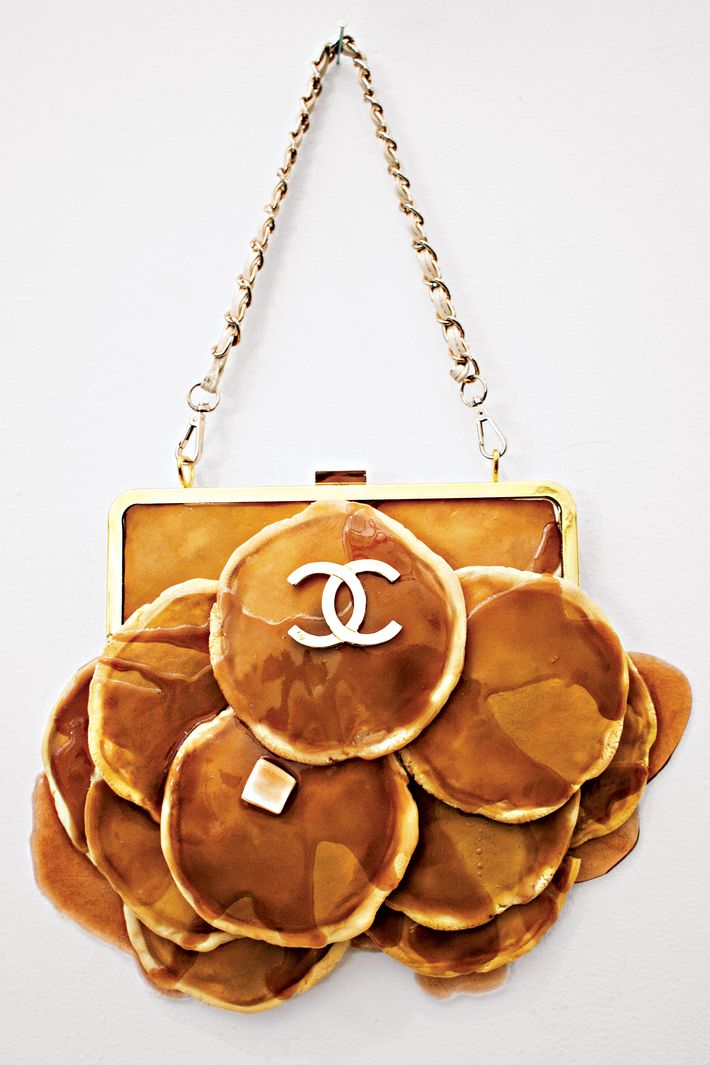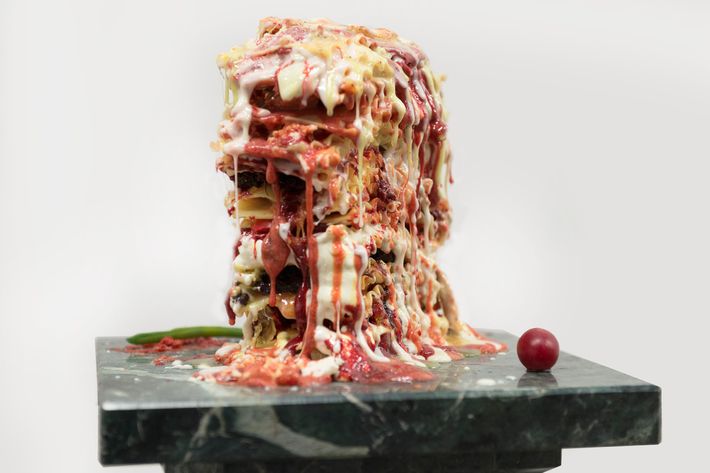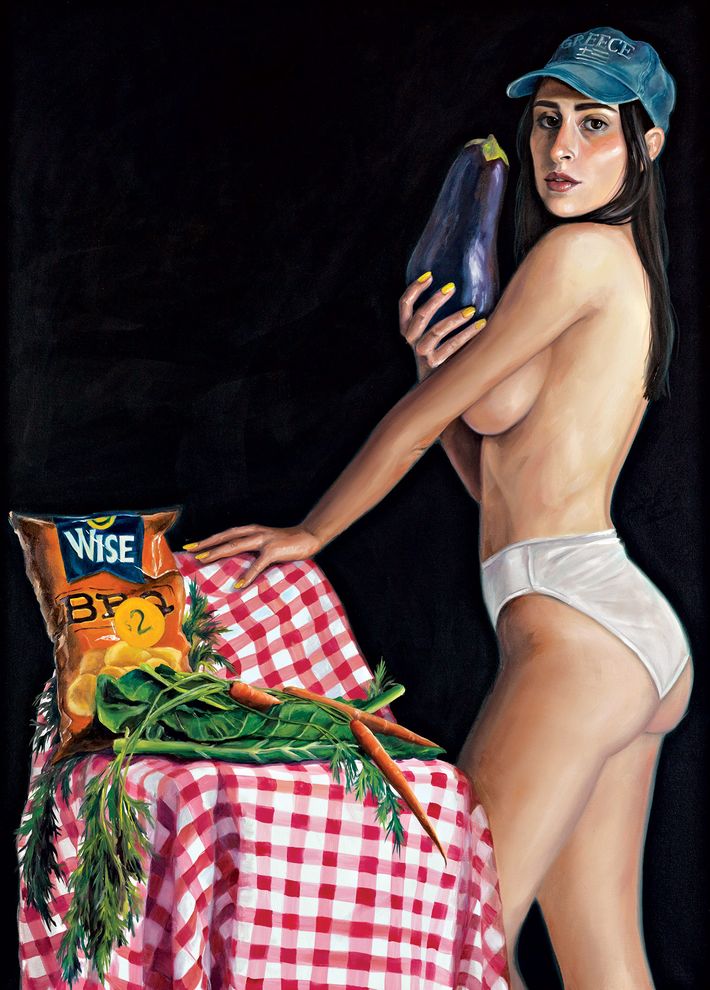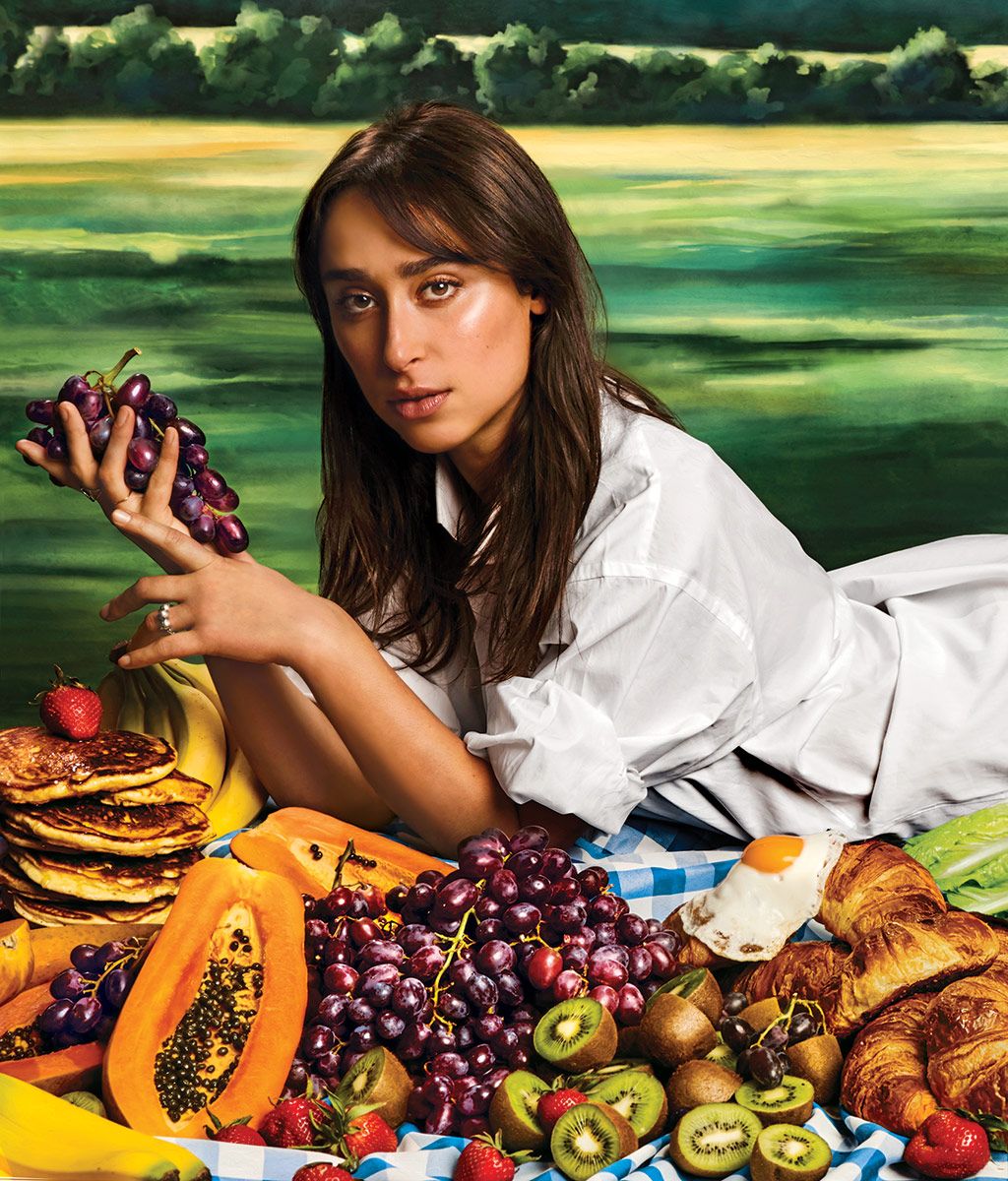Chloe Wise is so hot right now. Lit-er-al-ly, she would say, in that accent that has somehow transcended its Southern California roots to become the voice of an entire socioeconomic class. “I want to, like, dip myself into a pool of water,” she said, lifting her glossy dark hair off her neck. It was a blazing-hot Saturday in September, and Wise, 26, was standing next to an anemic tree in Seward Park on the Lower East Side, wearing a T-shirt and palazzo pants and dramatically waving a delicate wooden fan against her invisibly sweating skin.
The fans had been distributed by arty-cool label Eckhaus Latta to guests at its spring 2017 show, and Wise, who considers the designers and many of the models friends, had been in the second row snapping pictures as they walked down the runway.
Wise has a lot of friends. As people filtered toward the exit, so many came by to say hello that the area around the tree was soon buzzing with the energy of a cocktail party. A photographer circled the group, which consisted of people like Wise: young, of-the-moment artist-slash-somethings. There was trans model-activist Hari Nef, in glittery sunglasses and a red hat; India Salvor Menuez, the flame-haired actress who played Amy Adams’s daughter in Nocturnal Animals; and Carly Mark, known for her multimedia work with Haribo Gummi Bears. Two more artist-models eventually materialized, their eyeliner extra-smudgy in the heat. “Oh my God,” Wise greeted them. “You are so good at modeling.”
She sounded both sarcastic and genuine, which is pretty much the tone of her work. Wise makes paintings, sculptures, and videos that tread the line between having affection for and trolling aspirational millennial culture. Like her viral “Bread Bag” series, in which she affixed luxury logos to urethane carbohydrates and gave them names like Pancakes No. 5; her old-master-style paintings, which feature her subjects lounging with food items like Swiss chard; and her videos, in which Wise and her friends often recite things she’s overheard, or her friends have said, or “That I can’t believe I’ve said.” Such as: “I’ve had the avocado toast here 1,000 times,” or “A friend OD’d on Adderall at my birthday party, and it was iconic.” Or, “I realized I eat quinoa all the time, and I don’t know what it is.” She keeps a running list of it all on her iPhone.
“There’s a level where people will see it and be like, ‘Oh, that’s funny,’ ” says Eric Wareheim, of the comedy duo Tim and Eric, who is developing a video series with Wise. “And there’s a level where people will be like, ‘Oh, that’s Chloe’s world, the scene she’s part of.’ And there’s a level where it’s like, ‘That’s fucked up.’ ”
In the three short years she has been in New York, Wise has become a kind of “It” girl, part of a group of mostly female artists who are taking the concept of downtown scenester to a larger audience, mainly through social media. In addition to being a consistent presence socially, Wise has a robust presence on Instagram, where she entertains more than 60,000 followers with photos and videos of her doing things that are glamorous or gross or funny or all three, like smushing a cream-cheese-laden rainbow bagel while wearing silky magician gloves.
Wise’s youth, chosen subjects, and affinity for self-promotion have given rise to predictable grumblings from those who see her colorful figurative work as slight or trendy and sneer at her social presence. “Those bags were so annoying,” one critic at an arts publication moans to me over the phone. “Everyone is doing these figurative works that look really good on Instagram. But the real litmus test is if you Google an artist and it’s all photos at parties. And you Google her and it’s all, like, vanity shots.”
“Chloe doesn’t really play by the rules, and that makes her an interesting figure, one who is kind of misunderstood sometimes and even looked down on,” says Thor Shannon, an associate director at the gallery Gavin Brown’s Enterprise, whose lap Wise spent the Eckhaus Latta show seated on. “But that’s because she’s doing something new.”
Back at the park, the sun was beating down, and Wise was getting restless. “I want a watermelon smoothie,” she announced. “Come get a smoothie,” she said, repeating the command around the group until soon a small crowd was following her, palazzo pants swishing, as she headed to the fruit stand across the street, picking up stray fashionistas with her Pied Piper refrain: Come get a smoothie. I want a smoothie. Come get a smoothie.

Food is a recurring motif in Wise’s work. She loves, in particular, First World food trends. “Like, how often do people have to tell you their diets?” she said, standing in her Bushwick studio one day last spring. “ ‘I’m paleo.’ ‘I’m vegan.’ ‘I don’t give a shit, I eat burgers.’ It’s like a new thing to put out about what kind of person you are.”
At that moment, she was spending eight to 12 hours a day in her studio, working on a new food-based project, and the loft was strewn with fake romaine-lettuce leaves, piles of noodles, and glistening urethane fruits, the kind you find in front of cheesy restaurants, which is what she was going for. The sensual promises of chain restaurants are another obsession of hers, a topic she tackled in her 2015 video Offer Ending Soon!, in which she and her friends sexily recite menu lingo like “luscious cream sauce” in a way that makes it sound practically dirty. She was returning to the theme for a solo show in Montreal. “There will be maybe like noodles dripping down the side here,” she said, touching the side of a framed charcoal portrait of one of her friends. “On the top, as though somebody walked by and was just like, Ugh, and dropped it.” She shuddered.
Then there were the sculptures, which would include Olive Garden of Eden, a kind of deconstructed Caesar salad. “I’m going to do dressing dripping down in this kind of sickening, abject way,” she told me. “Really cascade-y and, like, messy. So it’s like dripping, oozing, sinful, naughty, bad, decadent, shameful, sort of sexual. And I’ll have this kind of crouton barging in, and maybe some piercings, to make it a bit more gross.”
Although she sometimes sounds like a Valley Girl, Wise has some serious ideas behind her work, referencing Marx’s critique of commodity fetishism and Cruel Optimism, University of Chicago professor Lauren Berlant’s monograph on the marketing of unachievable fantasies, as she moves about the faux lasagna and real coconut water in her studio. “Part of it is how women are addressed in the media, like, ‘You want to lose weight, you want to be healthy, you want to be the best you.’ For men, it’s like, ‘Enjoy yourself.’ For women, it’s like, ‘Cut back.’ And it truly affects us.”
Which is not to say she’s ready to renounce the material world. “I participate,” she said. “I’m on Instagram, and I’m like, ‘I have to get a spiralizer; they let you make noodles out of zucchini!’ I just think it’s a matter of like being aware and catching yourself and being like, ‘Oh my God, I’m so gullible.’ ”

Wise became aware of her own consumer desires “around bat-mitzvah age,” she’s said. Growing up in Montreal, she attended a progressive school that encouraged her to pursue her artistic endeavors. “Chloe was always so creative and so good and soft and kind, like a real good kid,” said her father, Richard, an accountant, who, along with Chloe’s mother, Melissa, frequently appears in her work, including in a Behind the Music–style parody, in which Wise and her sometime “beau” — snowboarder Mikkel Bang — play members of a death-metal band who wear full KISS makeup while on vacation at the family’s Florida condo.
Wise was “mind-blown” at age 16 when she discovered Tim and Eric Awesome Show, Great Job!, Tim Heidecker and Eric Wareheim’s experimental sketch-comedy show that spoofed bad TV with, among other things, parodies with a cable-access aesthetic. “It was the exact weird humor that I like,” she said. After high school, she studied studio art at Concordia University, which is how she met filmmaker Adam Levett, bonding over a Tim and Eric joke. They began collaborating on digital shorts, including PRTY, about a young woman who moves to the big city and becomes an “It” girl. Wise moved to New York not long after. “It’s such an amazing social scene, such great accessibility and visibility for young people and young women — female-identifying people — to make work,” she told me one afternoon, drinking an açai iced tea on the Lower East Side. “New York is where the hustle is.”
Wise has “incredible hustle,” says Ariel Schulman, the director of Catfish, who found PRTY on the internet and then struck up a friendship with her. Levett wasn’t too surprised when Wise also became friends with Eric Wareheim, whom she met in a restaurant. “She’s astonishingly good at connecting with people,” Levett says.
The first physical work Wise showed in New York was Star of Larry David, a five-pointed star made of bacon. “I thought it was the funniest, smartest thing I had seen in a while,” says Salon 94 curator Fabienne Stephan, who asked Wise to make a piece for Frieze in London. Wise responded by giving her a silicone mold of a friend’s chest, which she’d covered with a T-shirt and slathered in urethane so that it recalled spring-break-style wet-T-shirt contests.
At the time, Wise was still working as an assistant at Gavin Brown’s Enterprise, helping Scottish artist Martin Creed with an installation that required her to drive to Costco and buy 2,000 rolls of toilet paper. “You think, Okay, but that’s an enormous amount of toilet paper,” she said. “I was swerving all over the road. Imagine being cut off by a girl who had 2,000 rolls of toilet paper.” She went on to assist Brad Troemel, one of the provocateurs behind the Tumblr blog the Jogging, whose goal was to create art that went viral on social media and who preached about opening the rarefied art world to the masses.
“He gave me a lot of valuable advice,” said Wise. One piece of which was: Physical artwork hangs on a wall. But “the image has mobility,” she said. “It’s nomadic. Because of reblogs and tweets, it traverses the internet, getting endlessly reproduced, and ends up having a life of its own.”
By now, the story of Wise’s own viral art project has become something of a legend. Inspired by a Fendi Baguette, she created a line of bread-based luxury “handbags,” among them Bagel No. 5, a urethane bagel oozing with fake cream cheese and attached to a real Chanel chain she bought from a thrift store. The bags got their big break when her friend Menuez was invited to a Chanel dinner in Manhattan with Karl Lagerfeld and showed up wearing Bagel No. 5. The next day, the photos were everywhere, with fashion writers online flogging themselves for missing what was clearly a rare, exclusive Chanel product. “All these articles came out that were like, ‘New bagel bag, must have!’ ” said Wise. “Which was the whole conceit of the bread bag, that trends are based on nothing. Like, ‘Oh, if this was like $1,000 and Kendall Jenner wore it, everyone would be like, ‘Ooh, I love it.’ ” Disappointed though they may have been, many of the editors who called hoping to get their hands on one decided to interview her instead. “My morning beauty routine is waking up and taking ten to 400 nude selfies before leaving bed,” Wise gently teased one style website.
Wise’s social-media following skyrocketed, and she started getting offers from brands asking her to model or wear things on Instagram. “It was weird because I was kind of embraced by the fashion world at the same time I was critiquing it,” she said in her studio, which she began renting just as the bread bags took off.
As we were sitting there, the doorbell rang. It was a package from Marc Jacobs containing a handbag, a gift from the designer. “Holy shit,” she said, slinging it around her body. Wise was slightly wary at first about being too associated with commerce. But she’s since worked with some brands, like Acne and Marc Jacobs, whom she made a video for earlier this year, playing an adult-hotline operator in press-on nails. “A few years ago, people would have said, ‘Don’t any of you do that, it will ruin your career, because people have this idea that you can’t have co-existing intelligence and like your soul is taken away if you model for something. But I don’t think that’s true now,” she said. “I mean, look at Hari. She is not like a blank slate. People use her as a model because she is saying something. She is delivering a presence and an intelligence.”
She and Hari Nef met at Fashion Week in 2014. “Something special happens during Fashion Week among the kids who wind up on the same party circuit as you,” Nef later wrote for Dazed’s website. They collaborated with Levett in a video, and afterward, she and Wise bonded at Paul’s Baby Grand. “We were like, ‘This is going to be our year,’ ” she recalled.
And it kind of was. Soon, the high-end digital art mall Artsy was asking Wise to create an installation of bread bags for its exhibit at Art Basel, and Jeffrey Deitch asked her to contribute a piece to “Unrealism,” his show with Larry Gagosian at the fair. In deliberating over whom to paint, Wise thought of Nef, who had just been cast in Transparent. “I was like, ‘I don’t want to paint just anybody,’ ” she said. “I want to paint somebody who I think is important to paint right now, who is politically relevant and inspiring.”
I Remember Everything I’ve Ever Eaten, which features Nef outstretched on a checked picnic blanket with a container of Blue Diamond almond milk and a couple of suggestive-looking fruits, was “a sensation and of so much interest,” says Deitch, who recalls that the last night of the show, Wise’s 25th birthday, she came in to take a celebratory photograph before heading to the Artsy party on the beach. “I just remember thinking she was so young and so accomplished.”
Wise has grown close with the former MoCA director, whom she refers to as “Uncle Jeffrey.” “I’m always one who values the social side,” says Deitch, who wrote the intro to the book Wise published in October. ” I have been engaged in this 40 years, and a lot of the best artists, their contribution goes beyond making an interesting painting, it’s making a community. Chloe is one of most dynamic social connectors in New York City. She’s one of the people who makes the scene interesting.” This Passover, Deitch and Wise co-hosted a seder at his gallery, for which Wise designed a black-metal Haggadah and the curator, wearing a blue-and-gold headpiece over his trademark round glasses, performed the part of the Pharaoh in front of an audience that included artists like Marilyn Minter, Tom Sachs and Wise’s parents, who had flown in from Canada for the occasion. “I love that she invites her parents,” says Deitch. “No one in the ’70s has parents. They didn’t exist.”
“Chloe is all over the place, which is I think so emblematic of our time,” another guest, the glamorous model-curator Richie Shazam Khan, tells me. “How as a creative do we survive, what are the multitudes of things that we do?”
Although Wise shows with galleries in Montreal, Switzerland, and — as of last year — Parisian dealer Almine Rech; and despite the fact that her work is regularly featured in international art fairs, she is not necessarily considered a success in the Capital-A Art World. That is: In New York City, where she remains unattached to any gallery perceived to be a stepping stone to stardom. “Even though Chloe does her homework and goes to all the shows that quote-unquote matter, she’s not popping up in the places that would give an artist cred,” says Thor Shannon, who played Moses at the seder. Instead, she’s popping up in other places, like in Ariel Schulman’s movie Nerve, or at a party at Cipriani, where she was chatting with Leonardo DiCaprio. (“He was like, ‘Your art is amazing,” reported Khan. “I was like, ‘Go Chloe.’ ”) Or at more fashion shows. “I had to crawl over her to get to my seat at Opening Ceremony a few weeks ago,” one Artforum writer complains to me. Which might be part of the problem. “There’s this thing in the art world where people are kind of elitist and really political, they love how exclusive and opaque it is, and they invest a lot on keeping that in place because it keeps it mysterious,” says Shannon. “They don’t like things that are trendy, young artists that have a billion followers, and that may be why Chloe isn’t getting the validation that she maybe deserves.”
There may be another reason. “The art world is a deeply misogynistic place,” says the critic. “If you are an attractive young woman and you are going to parties and doing shoots in fancy clothes … But maybe she’s playing with that.”
Maybe she is. Wise is hyperaware of sexism in her chosen field, the “circle jerk of academics” who all too frequently “snub Instagram.” It was something we talked about many times. “Women have a hard time getting taken seriously if they engage with fashion or they engage with social media,” she told me at one point last year. “People are insecure about the co-existence of stuff. But things can harmoniously co-exist. Women can be smart and sexually active. Women can be funny and taken seriously.” It stands to reason that to some, the series of photos she had posted a few months earlier from a Mediterranean vacation with Wareheim and Aziz Ansari — which featured Wise posing in a bikini and pouring Champagne into the mouth of a shirtless Wareheim — appeared to be the cringeworthy result of a party girl’s drunken thumb. Though to others it looked more like a sly middle finger. “I think she’s kind of gamified herself,” says her friend Loreta Lamargese, Wise’s longtime friend and director at Arsenal Contemporary. “Like, What character am I in a film? I’m the popular Jappy princess girl! Instead of being like, I need to hide that, or That’s not marketable, what if I made that bigger than life?”

“Did I ever show you my Paris Hilton scar?” Wise asked her friend Carlos one night. It was Fashion Week, and we were in a car heading from the Kenzo party at the Metrograph on the Lower East Side to another party, at Gavin Brown’s Enterprise in Harlem.
“No,” he gasped.
She and Hilton had met through a mutual friend, and Wise pushed up her sleeve to exhibit a nubby white scar near her elbow. “She’s really smart. She’s like a full-blown business genius. But she acts stupid. We got along really well and then we were smoking and she burned my arm. I was drunk and didn’t notice until the next day.”
“Iconic,” he said.
Not long ago, Lamargese says, she was talking to a male artist who assumed Wise’s whole persona was a put-on, like Amalia Ulman, the artist who chronicled her fictional transformation into an L.A. “It” girl over Instagram in 2014. “He was like, ‘It’s all a charade,’ ” Lamargese says. “But it’s actually sincere. There is not another Chloe. She’s making fun of the yacht, but she’s on the yacht.” This winter, after she got back from a heavily documented trip to Asia with Wareheim and Ansari, Wise invited me to her new studio in the East Village, where she made us elaborate salads using her newly acquired spiralizer. “I can’t stop spiralizing!” Wise joked. “I’m on a downward spiral.”
Not really, though. “As a woman artist, it’s like everything not in your favor — do not get squashed by it,” she said. “For me, it’s like, okay, I get taken less seriously by certain academic people that maybe would consider me for a museum show I didn’t get into because they are like, ‘Oh, she’s like an Instagirl.’ But when I think of those five people versus like thousands of people who have maybe had their day or hour changed because I saw something beautiful or funny? That’s not even big numbers, but that’s a lot of people.”
That said, she had been a little bit bummed about her solo show in Montreal. Not because she was unhappy with how it turned out, but because it wasn’t in New York. “Unfortunately, some of my friends couldn’t see it, and never will, and when you work really hard on something and no one gets to see it in your life? That kind of sucks.”
But there was also the new studio, where she had started hosting dinners for women (and female-identifying persons) to process their feelings about Trump. “I’m calling it ‘Chloho House,’ ” she said brightly. And the web-or-maybe-tv series she was ginning up with Wareheim, and her upcoming solo show at Almine Rech, in Paris, in the fall. “The feminist thing to do,” Wise said as I left, “is to show how good you are.”
Later on, I remembered what happened during Fashion Week, after the taxi pulled up to the curb. “Did I tell you I met a boy with That’s Hot tattooed on his nipple?” Carlos had asked.
“Oh my God,” she said.
“I had to break up with him,” he sighed. “Because he could only speak to me in Lindsay Lohan.”
“Oh my God,” Wise said, and we waited while she opened up her Notes app and wrote it down.
Top photo: Food styling by Jamie Kimm; Makeup by Steven Canavan at L’Atelier NYC using Glossier; Hair by Kozmo for PHYTO Paris. Shoes by Prada.
*This article appears in the April 17, 2017, issue of New York Magazine.







